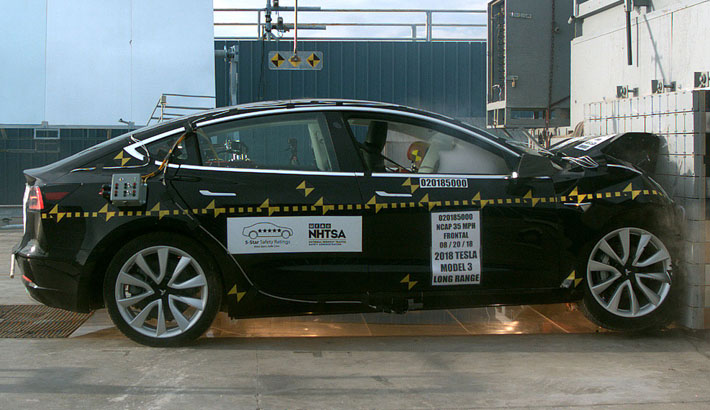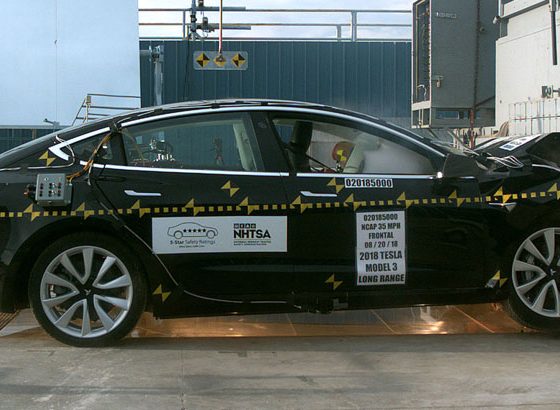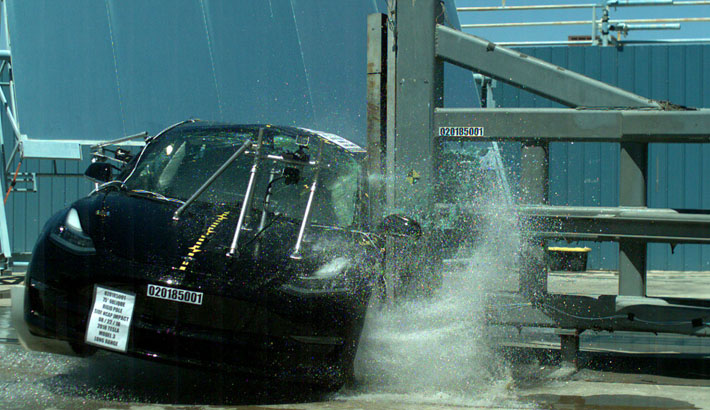

News
Tesla Model 3 named as vehicle with ‘lowest probability of injury’ by the NHTSA
The National Highway Traffic Safety Administration (NHTSA) has dubbed the Long Range RWD Tesla Model 3 as the vehicle with the lowest probability of injury among all cars that the agency has tested so far. The Model 3’s low likelihood of injury rating was given after the vehicle went through the NHTSA’s New Car Assessment Program, which involves a series of crash tests determining the likelihood of serious passenger injury for front, side, and rollover crashes.
The Model 3’s stellar rating from the NHTSA could be seen as yet another testament to the quality of Tesla’s all-electric cars. Immediately following the Model 3’s scores, after all, are the Model S and Model X, which are currently the vehicles considered by the NHTSA with the second and third lowest probabilities of injury. In a blog post announcing the electric sedan’s safety ratings, Tesla noted that it expects the Dual Motor AWD Model 3 to perform just as well in the NHTSA’s tests as its Long Range RWD sibling.
Part of the reason why the Model 3 is so safe is due to the vehicle’s all-electric design. Tesla opted to place the Model 3’s battery pack, the heaviest component of the vehicle, right at the car’s center of gravity. This gives the Model 3 performance and handling that is almost similar to that of mid-engine vehicles, while allowing the electric sedan to have a near 50/50 weight distribution. Other subtle design tweaks, such as the rear motor being placed slightly in front of the axle, further improve the Model 3’s weight distribution, as well as its overall agility and handling.
Model 3 provides superior safety with its front crumple zone which is optimized to absorb energy and crush upon impact https://t.co/RJEn0LlVNi pic.twitter.com/foF7CXPCc0
— Tesla (@Tesla) October 8, 2018
In true Tesla tradition, the Model 3’s all-electric architecture comprises of a sturdy, rigid passenger compartment, a fortified battery pack, and a low center of gravity. Just like its larger siblings, the Model S and X, the absence of an internal combustion engine in front and a fuel tank at the rear give the Model 3 extra large crumple zones, which are optimized to absorb energy and crush more efficiently in the event of an accident.
In the event of a frontal crash, the crumple zone at the front of the vehicle controls the deceleration of occupants, while the Model 3’s advanced restraint systems keep occupants safe in place. Passenger airbags are even specially designed to protect an occupant’s head in the event of an angled or offset crash, while active vents enable the vehicle to adjust the internal pressure of the frontal airbags when deploying. These systems optimize protection based on the specifics of an accident.
The Model 3’s energy-absorbing lateral and diagonal beam structures help occupants safe during pole impact crashes. These structures include a high-strength aluminum bumper beam, a sway bar placed close and forward in front of the car, cross members are the front of the steel subframe that are connected to the main crash fails, as well as diagonal beams in the subframe that distribute energy back to the crash rails when they are not directly impacted. An ultra-high-strength martensitic steel beam is further fitted on the front of the suspension to absorb crash energy from severe impacts.

Tesla also designed the Model 3 with a patented pillar structure and side sills to absorb as much energy as possible in a short distance. Coupled with the vehicle’s rigid body construction and fortified battery architecture, these design elements enable the Model 3 to reduce and prevent compartment intrusion in the event of an accident, while allowing its side airbags to have more space to inflate and cushion occupants.
Just like the Model S and Model X, the Model 3’s low center of gravity plays a key role in keeping the vehicle safe from rollover crashes. That said, even if a rollover does occur, Tesla notes that internal tests have shown that the Model 3 is capable of withstanding roof-crush loads equivalent to more than four times the electric sedan’s weight, far more than the NHTSA’s standards that require cars to withstand three times their own weight.
.@NHTSAgov will post final safety probability stats soon. Model 3 has a shot at being safest car ever tested.
— Elon Musk (@elonmusk) September 20, 2018
The Model 3 was recently given a flawless 5-Star Safety Rating in all categories and subcategories by the NHTSA. In a follow-up tweet to the NHTSA’s Model 3 results, Elon Musk noted on Twitter that the electric sedan has a shot at being the “safest car ever tested” by the agency. With the Model 3 being dubbed as the vehicle with the lowest probability of injury by the NHTSA, it appears that Musk’s statement has proven to be accurate.
Model 3 has the lowest intrusion from side pole impact of any vehicle tested by @NHTSAgov https://t.co/RJEn0LlVNi pic.twitter.com/ZvGCC82rEX
— Tesla (@Tesla) October 8, 2018
It’s not just the NHTSA that has given the Model 3 its approval, either. Earlier this year, the Insurance Institute for Highway Safety (IIHS), a nonprofit funded by auto insurers aimed at reducing accidents on the road, gave the Model 3 a “Superior” front crash avoidance rating. During the course of its testing, the Model 3 performed well in the crash avoidance and mitigation category, thanks to the vehicle’s Forward Collision Warning, its low-speed autobrake, and its high-speed autobrake systems. The Model 3 was also given a “Recommended” rating by Consumer Reports, after an over-the-air software update reduced the vehicle’s braking distance.
Tesla’s electric cars are known for their performance and their safety. The Model X, for one, also received 5-Star Safety Ratings in all categories and subcategories during the NHTSA’s tests. The Model S, on the other hand, performed so well during the NHTSA’s safety evaluation that the agency’s crash-testing gear broke while it was testing the electric sedan.

News
Tesla FSD fleet is nearing 7 billion total miles, including 2.5 billion city miles
As can be seen on Tesla’s official FSD webpage, vehicles equipped with the system have now navigated over 6.99 billion miles.

Tesla’s Full Self-Driving (Supervised) fleet is closing in on almost 7 billion total miles driven, as per data posted by the company on its official FSD webpage.
These figures hint at the massive scale of data fueling Tesla’s rapid FSD improvements, which have been quite notable as of late.
FSD mileage milestones
As can be seen on Tesla’s official FSD webpage, vehicles equipped with the system have now navigated over 6.99 billion miles. Tesla owner and avid FSD tester Whole Mars Catalog also shared a screenshot indicating that from the nearly 7 billion miles traveled by the FSD fleet, more than 2.5 billion miles were driven inside cities.
City miles are particularly valuable for complex urban scenarios like unprotected turns, pedestrian interactions, and traffic lights. This is also the difference-maker for FSD, as only complex solutions, such as Waymo’s self-driving taxis, operate similarly on inner-city streets. And even then, incidents such as the San Francisco blackouts have proven challenging for sensor-rich vehicles like Waymos.
Tesla’s data edge
Tesla has a number of advantages in the autonomous vehicle sector, one of which is the size of its fleet and the number of vehicles training FSD on real-world roads. Tesla’s nearly 7 billion FSD miles then allow the company to roll out updates that make its vehicles behave like they are being driven by experienced drivers, even if they are operating on their own.
So notable are Tesla’s improvements to FSD that NVIDIA Director of Robotics Jim Fan, after experiencing FSD v14, noted that the system is the first AI that passes what he described as a “Physical Turing Test.”
“Despite knowing exactly how robot learning works, I still find it magical watching the steering wheel turn by itself. First it feels surreal, next it becomes routine. Then, like the smartphone, taking it away actively hurts. This is how humanity gets rewired and glued to god-like technologies,” Fan wrote in a post on X.
News
Tesla starts showing how FSD will change lives in Europe
Local officials tested the system on narrow country roads and were impressed by FSD’s smooth, human-like driving, with some calling the service a game-changer for everyday life in areas that are far from urban centers.

Tesla has launched Europe’s first public shuttle service using Full Self-Driving (Supervised) in the rural Eifelkreis Bitburg-Prüm region of Germany, demonstrating how the technology can restore independence and mobility for people who struggle with limited transport options.
Local officials tested the system on narrow country roads and were impressed by FSD’s smooth, human-like driving, with some calling the service a game-changer for everyday life in areas that are far from urban centers.
Officials see real impact on rural residents
Arzfeld Mayor Johannes Kuhl and District Administrator Andreas Kruppert personally tested the Tesla shuttle service. This allowed them to see just how well FSD navigated winding lanes and rural roads confidently. Kruppert said, “Autonomous driving sounds like science fiction to many, but we simply see here that it works totally well in rural regions too.” Kuhl, for his part, also noted that FSD “feels like a very experienced driver.”
The pilot complements the area’s “Citizen Bus” program, which provides on-demand rides for elderly residents who can no longer drive themselves. Tesla Europe shared a video of a demonstration of the service, highlighting how FSD gives people their freedom back, even in places where public transport is not as prevalent.
What the Ministry for Economic Affairs and Transport says
Rhineland-Palatinate’s Minister Daniela Schmitt supported the project, praising the collaboration that made this “first of its kind in Europe” possible. As per the ministry, the rural rollout for the service shows FSD’s potential beyond major cities, and it delivers tangible benefits like grocery runs, doctor visits, and social connections for isolated residents.
“Reliable and flexible mobility is especially vital in rural areas. With the launch of a shuttle service using self-driving vehicles (FSD supervised) by Tesla in the Eifelkreis Bitburg-Prüm, an innovative pilot project is now getting underway that complements local community bus services. It is the first project of its kind in Europe.
“The result is a real gain for rural mobility: greater accessibility, more flexibility and tangible benefits for everyday life. A strong signal for innovation, cooperation and future-oriented mobility beyond urban centers,” the ministry wrote in a LinkedIn post.
News
Tesla China quietly posts Robotaxi-related job listing
Tesla China is currently seeking a Low Voltage Electrical Engineer to work on circuit board design for the company’s autonomous vehicles.

Tesla has posted a new job listing in Shanghai explicitly tied to its Robotaxi program, fueling speculation that the company is preparing to launch its dedicated autonomous ride-hailing service in China.
As noted in the listing, Tesla China is currently seeking a Low Voltage Electrical Engineer to work on circuit board design for the company’s autonomous vehicles.
Robotaxi-specific role
The listing, which was shared on social media platform X by industry watcher @tslaming, suggested that Tesla China is looking to fill the role urgently. The job listing itself specifically mentions that the person hired for the role will be working on the Low Voltage Hardware team, which would design the circuit boards that would serve as the nervous system of the Robotaxi.
Key tasks for the role, as indicated in the job listing, include collaboration with PCB layout, firmware, mechanical, program management, and validation teams, among other responsibilities. The role is based in Shanghai.
China Robotaxi launch
China represents a massive potential market for robotaxis, with its dense urban centers and supportive policies in select cities. Tesla has limited permission to roll out FSD in the country, though despite this, its vehicles have been hailed as among the best in the market when it comes to autonomous features. So far, at least, it appears that China supports Tesla’s FSD and Robotaxi rollout.
This was hinted at in November, when Tesla brought the Cybercab to the 8th China International Import Expo (CIIE) in Shanghai, marking the first time that the autonomous two-seater was brought to the Asia-Pacific region. The vehicle, despite not having a release date in China, received a significant amount of interest among the event’s attendees.








